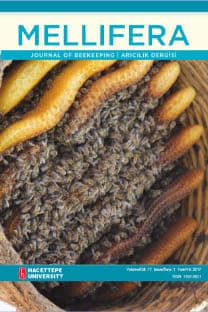Türkiye' de üretilen doğal ve yapay balların ayırt edilmesinde fiziksel, kimyasal ve mikroskobik analizler
Kontrollü koşullarda, Türkiye'nin çeşitli il ve ilçelerinde üretilen 127 doğal çiçek, 44 yapay çiçek, 33 doğal salgı ve 23 yapay salgı bal örneği olmak üzere toplam 227 bal örneği alınmıştır. Bu örneklerde elektrik iletkenliği (fiziksel) ile asillik, diastas sayısı, fruktoz, glikoz, jruktoz/'glikoz, sakkaroz, HMF, kül, potasyum, sodyum, KINa oram, pH, prolin ve rutubet (kimyasal) analizleri yapılmıştır. Doğal ve yapay balları ayırt etmek için bazı kimyasal ölçütlerin saptanmasının yanı sıra, balların mikroskobik polen analizleri de yapılarak, dominant nektar kaynağı bitkiler belirlenmeye çalışılmıştır. Sonuçta, doğal çiçek ballarının, yapay ballardan ayırt edilmesinde tüm faktörlerin ayırıcı faktör olduğu istatistiksel olarak saptanmıştır. Ayrıca, doğal salgı ballarının, yapay salgı ballarından ayırt edilmesinde de HMF ve sakkaroz dışındaki tüm faktörlerin ayırıcı olduğu yine istatistiksel olarak belirlenmiştir. Türkiye'nin ballarına kaynak oluşturan dominant nektar kaynağı bitkiler ise, Astragalus spp., Castanea sativa, Centaurea spp., Eryngium spp., Eucalyptus camaldulensis, Gossypium spp., Hedysarum spp., Helianthus annuus, Isatis spp., Lamium spp., Linaria spp., Lotus spp., Marrubium spp., Olea spp., Onobrychis spp., Pimpinella anisum, Salix spp., SaMa spp., Sophora spp., Teucrium spp., Trifolium spp., Triticum spp., Vida spp. ve Xanthium spp. olarak tespit edilmiştir.
Physical, chemical and microscopic analyses in distinguishing natural and artificial honey produced in Turkey
Under controlled conditions, a total of 227 honey samples were taken from different provinces and districts of Turkey. These samples included 127 natural and 44 artificial flower honeys, and 33 natural and 23 artificial honeydew honeys. These samples were analyzed in terms of electricity conductivity (physical), number of acidity, diastase, fructose, glucose, fructose/glucose, saccharose, HMF, ash, potassium, sodium, K/Na ratio, pH, proline and moisture (chemical). In addition to the identification of some chemical criteria to distinguish natural honey from artificial honey, honey samples were also subjected to microscopic pollen analysis to determine plants which are dominant as sources of nectar. Eventually, it was statistically proven that all these factors have their specific roles to play in distinguishing natural honey from artificial one. Also in distinguishing natural from artificial honeydew honey, it was proven statistically that all factors with the exception of HMF and saccharose had a determining role. The following are the dominant nectarous plants used in honey production in Turkey: Astragalus spp., Castanea saliva, Centaurea spp., Eryngium spp., Eucalyptus camaldulensis, Gossypium spp., Hedysarum spp., Helianthus annuus, Isatis spp., Lamium spp., Linaria spp., Lotus spp., Marrubium spp., Olea spp., Onobrychis spp., Pimpinella anisum, Salix spp., Salvia spp., Sophora spp., Teucrium spp., Trifolium spp., Triticum spp., Vicia spp., andXanthium spp.
___
- ISSN: 1302-5821
- Başlangıç: 2001
- Yayıncı: Hacettepe Üniversitesi
Sayıdaki Diğer Makaleler
Ankara ili ve çevresindeki arılıklarda teşhis edilen başlıca yavru hastalıklarının dağılımı
Uzun süre bekletilen kişniş balının kimyasal bileşimi ve antimikrobiyal özelliği
Ahmet Gaffer HEGAZİ, Faten K. Abd EL-HADY, M. A. EL-ANSARI, Fayroz A. M. ABD ALLAH, N. A. M. SALEH
Kadriye SORKUN, Nevin BAŞOĞLU, Yalçın GÜMÜŞ, Kemal ERGÜN, Nalan BULAKERİ, Nadir IŞIK, CAHİT DOĞAN
Çeşitli illerden toplanan arı sütünün antimikrobiyal aktivitesinin incelenmesi
Miraç YILMAZ, Gökçen ÇELİK, Nazime MERCAN, Nur Zehra YÜKSEKDAĞ, Yavuz BEYATLI
